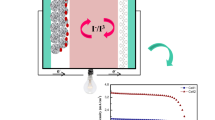Abstract
In the present work, uniform Polypyrrole (PPy) films were deposited on fluorine doped tin oxide substrates by chronoamperometry technique with various electropolymerization times. They were then investigated as counter electrodes (CEs) in dye-sensitized solar cells (DSSCs). Fourier transform infrared spectroscopy and contact angle measurements confirmed PPy polymerization efficiency. Scanning electron microscopy reveals the formation of unbounded PPy chains over the cauliflower structure at higher deposition times. The electrocatalytic activity of PPy films were found to decrease with increasing in deposition time. Similarly, the performance of PPy CE based-DSSCs is dependent upon polymer deposition time. DSSCs fabricated using PPy CE with 1s polymerization time exhibited higher photocurrent and thus superior power conversion efficiency. Electrochemical Impedance Spectroscopy suggests that the lower performance of DSSC with longer PPy deposition time is due to higher ion diffusion resistance in the porous structure of the formed unbounded PPy chains which retards the reduction of the triiodide ions \({ (I}_{3}^{-}\) ) at CE.










Similar content being viewed by others
Data availability
All data generated or analyzed during this study are included in this published article.
References
R.I. Malarselvi, G. Ragasudha, C.R. Raja, R. Priscilla, Mater. Today. (2021). https://doi.org/10.1016/j.matpr.2019.06.692
S. Shalindra, B. Gunasekera, I. Rangeeka, P. Samodha, S. Gunathilaka, Sol. Energy. (2020). https://doi.org/10.1007/978-981-15-0675-8_17
J.W. Li, Y. Chen, Y.F. Chen, J.X. Chen, C.F.J. Kuo, L.Y. Chen, C.W. Chiu, Polymers. (2021). https://doi.org/10.3390/polym13183103
S. Çakar, M. Özacar, F. Fındık, Micro. Nanotechnol. (2022). https://doi.org/10.1016/B978-0-323-91179-5.00033-4
H. Sun, Y. Luo, Y. Zhang, D. Li, Z. Yu, K. Li, Q. Meng, ACS Publications. (2010). https://doi.org/10.1021/jp1030015
K. Sharma, V. Sharma, S.S. Sharma, Nanoscale. Res. Lett. (2018). https://doi.org/10.1186/s11671-018-2760-6
D. Chen, Y. Zhao, Y. Fan, W. Wang, X. Li, Int. J. Hydrog. Energy. (2014). https://doi.org/10.1016/j.ijhydene.2013.12.075
G. Yue, J. Wu, Y. Xiao, J. Mi. Huang, Lina, J.Y. Lin, J. Mater. Chem. A. (2013). https://doi.org/10.1039/c2ta00860b
J.M. Pringle, V. Armel, D.R. MacFarlane, Chem. Commun. (2010). https://doi.org/10.1039/c0cc01400a
H. Kim, G. Veerappan, J.H. Park, Electrochim. Acta. (2014). https://doi.org/10.1016/j.electacta.2014.06.012
S. Shalindra, B. Gunasekera, I.R. Perera, S.S. Gunathilaka, Sol. Energy. (2019). https://doi.org/10.1007/978-981-15-0675-8_17
K. Saranya, M. Rameez, A. Subramania, Eur. Polym. J. (2015). https://doi.org/10.1016/j.eurpolymj.2015. (01.049)
H. Wenjing, X. Yaoming, H. Gaoy, Z. Haihan, Electrochim. Acta. (2016). https://doi.org/10.1016/j.electacta.2016.01.012
M. Xingping, Y. Gentian, W. Jihuai, L. Zhang, Nanoscale Res. Lett. (2015). https://doi.org/10.1186/s11671-015-1015-z
S.S. Jeon, C. Kim, J. Ko, S.S. Im, J. Mater. Chem. (2011). https://doi.org/10.1039/C1JM10112A
C. Bu, Q. Tai, Y. Liu, S. Guo, X. Zhao, J. Power Sources. (2013). https://doi.org/10.1016/j.jpowsour.2012.07.117
F.Z. Tighilt, S. Belhousse, A. Rahal, K. Hamdani, N. Belhaneche, S. Sam, K. Lasmi, Silicon. (2022). https://doi.org/10.1007/s12633-021-01189-y
K. Hamdani, M. Adnane, S. Sam, D. Chaumont, S. Belhousse, F.Z. Tighilt, K. Lasmi, A. Hamrani, Emerg. Mater. Res. (2019). https://doi.org/10.1680/jemmr.18.00088
A.G. Thate, K.S. Pakhare, S.S. Patil, V. Bhuse, Res. Chem. Intermed. (2023). https://doi.org/10.1007/s11164-022-04878-4
E. Supriyanto, L. Ni’mah, S. Sujito, N. Alviati, A. Dikayanti, A.G.E. Sutjipto, AIP. Conf. Proc. (2023). https://doi.org/10.1063/5.0118273
W. Hou, Y. Xiao, G. Han, Electrochim. Acta. (2016). https://doi.org/10.1016/j.electacta.2016.01.012
A. Mollahosseini, E. Noroozian, Synth. Met. (2009). https://doi.org/10.1016/j.synthmet.2009.02.015
M. Šetka, J. Drbohlavová, J. Hubálek, Sensors. (2017). https://doi.org/10.3390/s17030562
X.M. Feng, Z.Z. Yan, R.M. Li, X.F. Liu, W.H. Hou, Polym. Bull. (2013). https://doi.org/10.1007/s00289-013-0952-x
J. Jang, J. Bae, Sens. Actuators. B.: Chem. (2007). https://doi.org/10.1016/j.snb.2006.05.002
C. Basavaraja, W.J. Kim, D.G. Kim, D.S. Huh, Mater. Chem. Phys. (2011). https://doi.org/10.1016/j.matchemphys.2011.05.057
H.C. Kang, K.E. Geckeler, Polymer. (2000). https://doi.org/10.1016/S0032-3861(00)00116-6
J. Huo, M. Zheng, Y. Tu, J. Wu, J. Mater. Sci.: Mater. Electron (2016). https://doi.org/10.1007/s10854-016-4478-5
C.T. Thanh Thuy, J.H. Jung, S. Thogiti, W.S. Jung, K.S. Ahn, J.H. Kim, Eectrochim. Acta. (2016). https://doi.org/10.1016/j.electacta.2016.04.099
M. Towannang, S. Pimanpang, A. Thiangkaew, P. Rutphonsan, W. Maiaugree, V. Harnchana, W. Jarernboon, V. Amornkitbamrung, Synth. Met. (2012). https://doi.org/10.1016/synthmet.2012.08.017
K. Keothongkham, S. Pimanpang, W. Maiaugree, Int. J. Photoenergy. (2012). https://doi.org/10.1155/2012/671326
S.C. Pradhan, S. Soman, Results. Surf. Interfaces. (2021). https://doi.org/10.1016/j.rsurfi.2021.100030
S.G. Hashmi, G.G. Sonai, H. Iftikhar, P.D. Lund, A.F. Nogueira, Semicond. Sci. Technol. (2019). https://doi.org/10.1088/1361-6641/ab39f0
Acknowledgements
We acknowledge the National Research Fund (DGRSDT) and the Centre de Recherche en Technologie des Semi-conducteurs pour l’Energétique (CRTSE).
Funding
All of the sources of funding for the work described in this publication are financed by the General Directorate for Scientific Research (DGRSDT) and the Semiconductor Research Center for Energy (CRTSE).
Author information
Authors and Affiliations
Contributions
FZT: Initiation of the work, polypyrrole grafting on the ITO and interpretation of the results. SB: Interpretation of FT-IR results. KH: Elaboration of photoanode. YA: Electrodeposition of Polypyrrole. MM: Study of electrocatalytic activity. HL: assembly of a dye cell. KL: Characterization of different structures by contact angle measurements. AM: Interpretation of MEB results. NB: Contribution to the correction of the article. SS: Simulation and impedance study.
Corresponding author
Ethics declarations
Competing interests
We wish to confirm that there are no known conflicts of interest associated with this publication.
Additional information
Publisher’s Note
Springer Nature remains neutral with regard to jurisdictional claims in published maps and institutional affiliations.
Rights and permissions
Springer Nature or its licensor (e.g. a society or other partner) holds exclusive rights to this article under a publishing agreement with the author(s) or other rightsholder(s); author self-archiving of the accepted manuscript version of this article is solely governed by the terms of such publishing agreement and applicable law.
About this article
Cite this article
Tighilt, F.Z., Belhousse, S., Hamdani, K. et al. Influence of the electropolymerization time on polypyrrole-based counter electrode properties in dye-sensitized solar cell. J Mater Sci: Mater Electron 34, 1563 (2023). https://doi.org/10.1007/s10854-023-10902-z
Received:
Accepted:
Published:
DOI: https://doi.org/10.1007/s10854-023-10902-z




